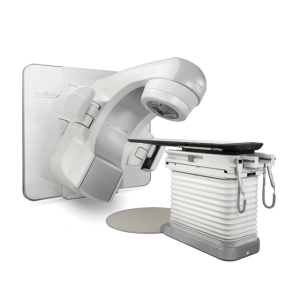Special report: Emerging technology in radiotherapy
by
Olga Deshchenko, DOTmed News Reporter | October 11, 2010

Varian TrueBeam STx
system
This article originally appeared in the October 2010 issue of DOTmed Business News.
The success of radiation therapy for the more than half a million patients who receive the treatment annually is governed by the ability to destroy the tumor while sparing normal tissue around it. In recent years, advances in intensity modulated radiation therapy (IMRT) and image guided radiation therapy (IGRT) have proven radiotherapy to be an indispensable, noninvasive option for cancer treatment.
But, earlier this year, safety concerns fueled by media coverage of overexposure accidents placed the industry in the national spotlight. Today, OEMs, end-users and regulators are collaborating on enhancing the safety of the treatment process, while research and innovation continue to drive the industry forward.
Market status
The global radiotherapy market experienced double-digit growth during the last few years, with the US holding a 50 percent share of the market, according to a 2010 report by Koncept Analytics, an India research firm. In the U.S., a high rate of cancer incidence paired with rapid acceptance of new treatment methods and reimbursement rates have driven the industry, according to the report.
However, 2009 proved to be a tough year for sales. But the downturn in the economy might not be bad news for all in the sector – ISOs experienced an uptick in business.
“We certainly have seen an increase in service because people are keeping their machines longer. We’ve actually had to hire new people to meet the demand,” says Steve Schwarz, CEO of Acceletronics, the world’s largest employee-owned independent radiation oncology equipment service organization.
OEMs say the U.S. market is looking up this year and there’s a lot of potential abroad, where many patients remain underserved.
“Despite the fact that radiation therapy is widely utilized in North America and in Western Europe, as a noninvasive treatment that is so effective, it could be serving a lot more patients as one of the steps toward managing their disease,” says Karla Donohoe, senior marketing director with Varian Medical Systems. “That is particularly the case in markets like India, China and a number of areas in Latin America, where there are many fewer radiotherapy treatment centers per capita than we see in North America and Western Europe.”
Although Asia is a lucrative market for radiotherapy, expanding treatment to the region is a challenging task.
“The number of linear accelerators per population is very, very low in that part of the world,” says Timothy Prosser, director, oncology business line management with Elekta. “China doesn’t have a problem with money [but with staffing] its cancer centers. It’s the only thing restraining the market right now.”
